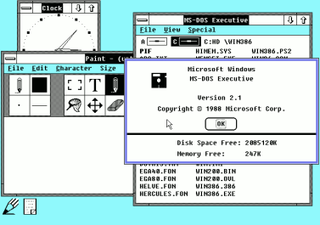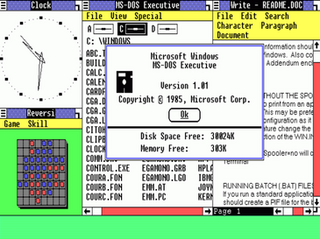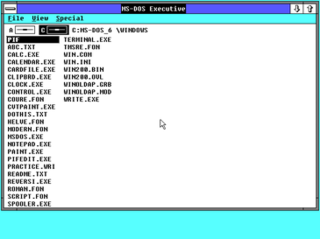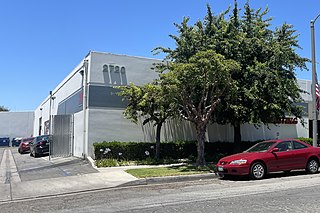
The IBM PC Convertible is a laptop computer made by IBM, first sold in April 1986. The Convertible was IBM's first laptop-style computer, following the luggable IBM Portable, and introduced the 3½-inch floppy disk format to the IBM product line. Like modern laptops, it featured power management and the ability to run from batteries.

Ziff Davis, Inc. is an American digital media and internet company. First founded in 1927 by William Bernard Ziff Sr. and Bernard George Davis, the company primarily owns technology- and health-oriented media websites, online shopping-related services, internet connectivity services, gaming and entertainment brands, and cybersecurity and martech tools. Previously the company was predominantly a publisher of hobbyist magazines.

Computer Gaming World (CGW) was an American computer game magazine published between 1981 and 2006. One of the few magazines of the era to survive the video game crash of 1983, it was sold to Ziff Davis in 1993. It expanded greatly through the 1990s and became one of the largest dedicated video game magazines, reaching around 500 pages by 1997.

The IBM 3270 PC, released in October 1983, is an IBM PC XT containing additional hardware that, in combination with software, can emulate the behaviour of an IBM 3270 terminal. It can therefore be used both as a standalone computer, and as a terminal to a mainframe.

Formula 1 is a racing video game developed by Bizarre Creations and published by Psygnosis for PlayStation and Microsoft Windows. It is the first installment in Sony's Formula One series.

The Epson Equity series of IBM Compatible Personal Computers was manufactured from 1985 until the early '90s by Epson Inc. Epson was well known for its dot matrix printers at the time and the Equity series represents their entry into the growing PC compatible market. The Equity I was the first system introduced, equipped with an Intel 8088 CPU and one or two 5.25" floppy disk drives.

Windows 2.1 is a major release of Microsoft Windows. It was released to manufacturing on May 27, 1988, as a successor to Windows 2.0.

Windows 1.0 is the first major release of Microsoft Windows, a family of graphical operating systems for personal computers developed by Microsoft. It was first released to manufacturing in the United States on November 20, 1985, while the European version was released as Windows 1.02 in May 1986.

Windows 2.0 is a major release of Microsoft Windows, a family of graphical operating systems for personal computers developed by Microsoft. It was released to manufacturing on December 9, 1987, as a successor to Windows 1.0.
North Star Computers Inc. was an American computer company based in Berkeley, California existing between June 1976 and 1989. Originally a mail order business for IMSAI computers, it soon developed into a major player in the early microcomputer market, becoming first known for their low-cost floppy disk system for S-100 bus machines, and later for their own S-100 bus computers running either the CP/M operating system or North Star's own proprietary operating system, NSDOS. North Star BASIC was a common dialect of the popular BASIC programming language. They later expanded their lineup with dual-CPU machines able to run MS-DOS, and a server version running either DOS or Novell NetWare.

PC Globe is an atlas for MS-DOS, Microsoft Windows, Apple Macintosh and Atari ST, first released in 1987 by Comwell Systems Inc. It offered information on 177 countries and dependencies.
Raxco Software Inc. is a Gaithersburg, Maryland software company. Founded in 1978, the company's products have been sold internationally.

The LTE Lite was a series of notebook-sized laptops under the LTE line manufactured by Compaq from 1992 to 1994. The first entries in the series were Compaq's first computers after co-founder Rod Canion's ousting and Eckhard Pfeiffer's tenure as the new CEO. The notebooks were co-developed and manufactured by Compaq and Citizen Watch of Japan. They were a hot-seller for Compaq and spanned multiple models, with various processors and liquid-crystal display technologies.

The Sharp PC-7000 is a luggable portable computer released by Sharp Electronics in 1985. The PC-7000 was Sharp's second entry into the IBM PC-compatible portable computer market, their first being the PC-5000.

American Computer & Peripheral, Inc. (AC&P), also written as American Computer and Peripheral, was an American computer company based in Santa Ana, California. The company was founded in 1985 by Alan Lau and released several expansion boards for the IBM PC as well as a few PC clones before going bankrupt in December 1989. Obscure in its own time, the company's 386 Translator was the first plug-in board for Intel's newly released 80386 processor and the first mass-market computing device to offer consumers a means of using the 386 in July 1986.
The PB286LP, released in 1989, was Packard Bell's first laptop computer. The laptop featured an 80C286 processor clocked at 12 MHz and 1 MB of RAM, along with a single ISA expansion slot. Packard Bell released the PB286LP in 1989 among a slew of products aimed at the corporate market. Technology writers gave it mostly positive reviews, although some noted its 16-lb weight as hefty and its monochrome LCD as somewhat flawed. Originally only capable of CGA-mode graphics, the laptop was updated in 1990 to support VGA. Packard Bell discontinued the PB286LP in 1991, in favor of more-compact, notebook-sized computers.

The Satellite A series was Toshiba Information Systems's premium consumer line of Satellite laptops. Introduced with the A10 and A20 models in 2003, the A series originally targeted high school and college students and workers of small offices and home offices, before becoming a premium line by the late 2000s.

The Personal System/2 Model 30 and Personal System/2 Model 30 286 are IBM's entry-level desktop computers in their Personal System/2 (PS/2) family of personal computers. As opposed to higher-end entries in the PS/2 line which use Micro Channel bus architecture, the Model 30 features an Industry Standard Architecture bus, allowing it to use expansion cards from its direct predecessors, the PC/XT and the PC/AT. The original PS/2 Model 30 is built upon the Intel 8086 microprocessor clocked at 8 MHz; the Model 30 286 features the Intel 80286 clocked at 10 MHz.
Intelligent Systems Corporation (ISC) was an American technology company that sold portable computers, video terminals, expansion cards, and other peripherals through a variety of manufacturing subsidiaries. Founded in 1973, the company restructured as a master limited partnership in 1987, becoming Intelligent Systems Master Limited Partnership.
Quasar Data Products Inc. (QDP), later QDP Computer Systems Inc., was an American computer company based in 1979 in North Olmsted, Ohio, United States. The company was founded by Brian A. Catalucci and Dave L. Kelley, the former a trained engineer who had previously worked as an airline pilot.















